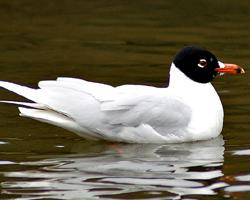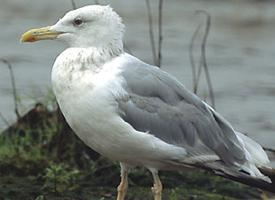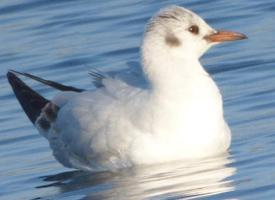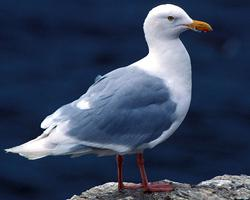
Stav ohrožení
| Ohrožen |
Popis zvířete
The Mediterranean Gull (Ichthyaetus melanocephalus) is a captivating bird species belonging to the Laridae family, which encompasses gulls and terns. This medium-sized gull is distinguished by its striking appearance and intriguing behavior, making it a subject of interest among birdwatchers and ornithologists alike. The species primarily inhabits areas around the Mediterranean Sea, hence its name, but its range extends to parts of Western Europe and the Black Sea region, showcasing its adaptability to different coastal and inland environments.Adult Mediterranean Gulls exhibit a distinctive plumage that is hard to miss during the breeding season. They possess a pristine white body contrasted sharply by a deep black hood that covers their head, extending from the bill to the nape. This black hood is complemented by bright red beaks and legs, adding to their striking appearance. Their eyes are adorned with a thin white eye-ring, which gives them a piercing gaze. One of the notable features of their plumage is the pure white primaries, lacking the black tips commonly seen in other gull species, which contributes to their elegant flight appearance.
Outside the breeding season, the Mediterranean Gull undergoes a transformation in which the black hood recedes, leaving a mostly white head with merely a few black spots, and their bill and legs may fade in color intensity. Juveniles and first-year birds present a more mottled appearance with brown and grey patterns across their feathers, gradually acquiring the adult plumage over several years.
Measuring approximately 36 to 38 cm in length with a wingspan of 98 to 105 cm, the Mediterranean Gull is slightly smaller than the closely related and more widespread Herring Gull. Its diet is versatile, consisting of a variety of food items including small fish, insects, crustaceans, and even scraps from human activities, showcasing its opportunistic feeding behavior.
Mediterranean Gulls are social birds, often found in flocks, especially during migration and wintering. They breed in colonies, sometimes alongside other gull species, where they construct nests on the ground made of vegetation and debris. Both parents are involved in nurturing the young, which fledge after about 5 to 6 weeks, demonstrating a strong parental commitment to their offspring's survival.
The call of the Mediterranean Gull is a distinctive "kree-ar" sound, which is softer and more melodious than that of many other gull species, adding an auditory allure to its presence. During breeding season, these calls become more frequent as part of their courtship and territorial behaviors.
In terms of conservation status, the Mediterranean Gull is currently listed as Least Concern by the International Union for Conservation of Nature (IUCN), indicating a stable global population. However, like many bird species, it faces threats from habitat loss, pollution, and climate change, underscoring the importance of continued monitoring and conservation efforts to ensure its survival.
The Mediterranean Gull, with its elegant appearance, fascinating behaviors, and melodious calls, is undoubtedly a jewel of the coastal and inland waterways it inhabits. Its presence enriches the biodiversity of its range and offers a captivating spectacle for those fortunate enough to observe this beautiful bird in its natural habitat.
Podobná zvířata
Nové fotografie zvířat
Top 10 zvířat
- Common cockchafer (Melolontha melolontha)
- Common house mosquito (Culex pipiens)
- Colossal squid (Mesonychoteuthis hamiltoni)
- Giant house spider (Eratigena atrica)
- Harpy eagle (Harpia harpyja)
- Fruit fly (Drosophila melanogaster)
- Common reed warbler (Acrocephalus scirpaceus)
- Australian box jelly (Chironex fleckeri)
- Proboscis monkey (Nasalis larvatus)
- Moustached guenon (Cercopithecus cephus)


